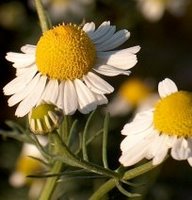The Chamomile Flower Is Not Just For Looks

The chamomile flower is not just a flower that is pretty; it is also a great remedy for many things. You may not even realize all the things that chamomile can help with, but there are a lot. This one herb can be of help no matter what stage of life you are in. It can help with babies, all the way to older people, and everybody in between. Here are some of the many things you can use chamomile for.
We'll start with the little ones. Chamomile tea can help a colic baby feel better. It soothes their upset tummy. You can also use chamomile tea to help with a fussy baby who is teething. You do need to make sure you make the tea an appropriate strength depending on the child's age. Chamomile tea is a great natural way to help your little one start feeling better in no time.
If you have had a stressful day at work you might try a bath with some chamomile. Put some chamomile in a cheesecloth bag and tie it shut and fill your tub two thirds of the way full with hot water. After ten minutes you of letting the chamomile soak in the water add cold water until it is the desired temperature. Now all you need to do is sit back and relax and let the chamomile work its magic. This is a great way to relax before bed too.
Chamomile is also known for softening the skin. The chamomile bath will also help soften your skin. Lotions are also now made with chamomile. Soap is another item that chamomile is now being put in.
Chamomile tea will not only help your little one, it can help you feel better as well. If you are suffering form menstrual cramps you may want to try some tea. In addition to helping subside the pain of cramps, chamomile tea can also be used to regulate your period. Chamomile can also help soothe those painful backaches that come with your monthly cycle.
Chamomile can help you when you are sick with a cold or the flu as well. The tea will help soothe a sore throat, or stomach cramps, or sore muscles, or many other aches and pains. What a great way to naturally relieve your aches and pains. You don't have to run to the medicine cabinet for some aspirins every time you have an ailment, you may want to try some chamomile tea instead. With chamomile in the house you are sure to help ease someone's pain. So, next time you go to the store don't forget to pick up your chamomile tea, remember it is safe natural, and wallet friendly.
Article Source: http://www.article-exposure.com
Gregg Hall is an author living in Navarre Florida. Find more about this as well as flower arrangements at www.flowerarrangementsandplants.com





